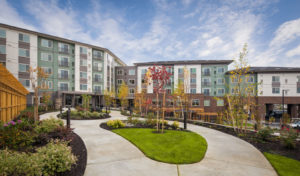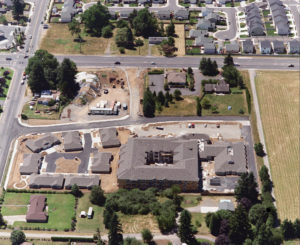Solutions for Complex Senior Living Construction
By: Dan Cowley, Pence Construction | September, 2017

For anyone in the senior living construction business, understanding the ever‐changing rules and regulations surrounding the process is necessary. Like all construction projects, the success of the final inspection begins in the initial stages of design. Hiring a contractor who knows the industry, the local laws, and has a plan for both is the surest way for senior living capitol investors and developers to achieve a timely, profitable, and successful project completion.
General contractors should constantly be reviewing new regulations and updating internal processes and procedures to meet those requirements as soon as possible. For example, in one of Oregon’s latest regulation updates, any floor in a wet condition (janitor’s closet or bathroom) must have a self‐coved base with no seams. Not only is this an additional design detail to get on the plans immediately, but the cost difference between standard rubber base and a self‐coved model is significant at approximately a 25% increase.
That type of cost increase on a large senior living building could be substantial, especially if it is a checklist item during the state inspections. Builders can plan for this type of cost impact during preconstruction during constructability/ licensing review. If noticed too late, budgets could suffer. Preconstruction is the key to success. Senior living property owners and developers need to hire a general contractor familiar with the local regulations and ask tough questions about their experience with the city and state agencies that govern the process.

Questions about how the GC handles accessibility, safety and comfort are of utmost importance for both the inspection process and your end user. These pieces are addressed in detail during preconstruction. Contractors and owners alike may consider the creation of a custom checklist of requirements based on experience and past performance.
Understanding the players is another key component of senior living construction work. The relationship between the owner/operator, state and local agencies—including Fire Marshall, the Authority Having Jurisdiction and DHS—plus the added complication of local laws and standards all require the GC to maintain a strong connection to all the above. Getting to know the Fire Marshall and his or her style, or the time constraints on local jurisdictions to complete inspections is imperative in maintaining schedule.
Ultimately, senior living owners need to select GCs who know the industry, have their own quality control and planning processes, and understand the regulation landscape. Getting into the details early and not relying on outside agencies to provide information to your team will pay back dividends when inspections are completed successfully and your residents are happy with their home.
——

Dan Cowley is a Senior Project Manager with Pence Construction. Dan has managed the construction of 29 senior living communities across the continuum of care including The Ackerly at Timberland and Quail Park of Lynnwood. Pence is a general contractor located in Salem and Portland, Oregon with clients spanning the entire West coast.


© 2025 Pence Contractors.
All Rights Reserved.